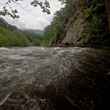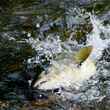I worked the barbless Clouser free from the mouth of the third straight toothy Spanish mackerel and wondered why on earth this place was named for tarpon when it seemed much more appropriate to name it after this salty rocket that I cradled in my hands.
I stood on tiny sand spit at the mouth of southwest Florida’s Tarpon Bay on an incoming tide, casting the red and black Clouser that Florida fly fishing legend Norm Zeigler recommended to me the day before into the rushing current. It was a lot like throwing streamers at big browns on the Henry’s Fork.
Only, on the Henry’s Fork, you don’t need watch the water around your ankles for big jellyfish cruising along with current. One brush with these bulbous mucous-masses will ruin your day, for sure.
The macks would hit just as the retrieve started—and if they didn’t, a feisty ladyfish or a spotted sea trout almost surely would. The trout were fun, but generally no longer than a foot. The ladyfish were a kick, but they tended to go airborne with the current and almost deposit themselves on the sand next to me. But the mackerel… they turned tail and ripped into the depths, often peeling 7-weight line from the reel in the process.
They’re stunning fish, and I’ve caught their brethren—Sierra mackerel—in the cooler waters of the Sea of Cortez off the coast of Baja before. And I caught a truly big Spanish mackerel off the Port Arkansas jetty in Texas a few years back. But these—while not as big—were spirited fish and you had to admire the ferocity with which they hammered the streamer. They fought like fish twice their size, and no fly fisher worth his salt would be anything but impressed at the mouthful of teeth these bruisers show off when they come to hand.
I had paddled out to the little sand spit at the lull of a low tide in a kayak courtesy of the folks at Tarpon Bay Explorers—they rent kayaks to anglers and paddlers and offer a sight-seeing tour to folks who’d rather not get too close to the water. Tarpon Bay itself resides within the Ding Darling National Wildlife Refuge and is home to all kinds of fishy denizens, like tarpon, redfish and snook, as well as the “lesser” critters I was catching on this beautiful October day. Throw in manatees and the occasional alligator, and Tarpon Bay hosts a pretty lively food chain.

I didn’t start the day chasing trout, ladyfish and mackerel. I was much more interested in the redfish and snook that prowl the bay’s waters, and I did get to cast to some disinterested black drum on a flat just a short paddle from the launch. But the water in the bay was off-color thanks to an influx of untreated “fresh” water from the Caloosahatchee River, so sight-casting to larger fish was off the menu. Instead, I did what any knowledgeable trout angler would do—I found structure and current and started casting. It proved productive, and I suppose I could have stayed at that little choke-point for hours.
But I wanted to explore.
Over the course of a morning, I paddled all around Tarpon Bay—when I wasn’t anchored and casting into the tidal flow at the mouth of the bay for macks and such, or anchored over a grass flat in hopes of hooking into some trout and ladyfish (or redfish, for that matter), I’d paddle along, and trolled the Clouser or one of Zeigler’s famed Schminnows about 30 feet behind me. Whenever I lucked into a fish, I’d drop anchor and start casting—it seemed to work pretty well, and by the time I got back to the launch just before lunchtime, my shoulders were shot, both from padding, and from casting to salty critters all morning.

This little corner of Florida isn’t as famous as the Keys or the Everglades, but it’s plenty fishy, even with the dark water that comes coursing into the estuaries during the rainy season. In addition to paddling Tarpon Bay for all its bounty, Sanibel and Captiva islands also offer some truly lively beach fishing. When the water’s clear, it’s possible to sight-cast to pods of snook moving along the beach, sometimes to within feet of the sand. Ladyfish, trout, jacks and mackerel also prowl the modest breaks in search of baitfish—and the surf is never truly big, making it ideal for fly fishers.
If finding a bit of backcountry amidst the bustle of south Florida is something you’re interested in doing, fishing the refuge via a kayak is a pretty unique experience. And the beaches… well, if you get tired of casting to hungry ladyfish and trout with multi-million dollar homes as you backdrop, you can always take a dip in the Gulf of Mexico or wander the beach in search of shells and sand dollars. Along Sanibel, the water is shallow and quite clear—along Captiva it’s clear, but the drop-off is a bit deeper the farther you get from the beach.
And, if you’re into the local scene, you can’t do much better—both economically and in terms of location—than to book a room at ‘Tween Waters Inn. Not only are you a five-minute walk to the beach, you can take in the local nightlife at the Crow’s Nest (the crab races on Tuesday night are a kick in the pants—and this writer is the proud owner of a third-place ribbon at a recent event). The resort also offers kayak and canoe rentals, and rumor has it, big snook hang out at night under the lights when the baitfish move in. The resort, as the name implies, rests between the Gulf of Mexico and San Carlos Bay—both very fishy bodies of water.

According to Zeigler, the snook run along the beaches starting in late April or early May, and they don’t stop until October—sometimes later. It’s a great shoulder-season destination for snow-bound trout anglers. Keep in mind, too, that summer in south Florida is “off season,” given the heat and humidity that settle atop the region. If you can handle those elements, chances are, you’ll be fishing the beach of the bay all by your lonesome.
Sounds good, doesn’t it?
Chris Hunt is the national communications director for Trout Unlimited. He blogs frequently at tu.org and at eatmorebrooktrout.com.

































Comments
Tom Rosenbauer replied on Permalink
Love Spanish. They have saved the day for me so many times--and any member of the tuna family is always a hoot on a fly rod.
stabler replied on Permalink
Had no idea that mackerel were in the tuna family ... pretty surprising given how different the flesh is.
ginkthefly replied on Permalink
I'm making the safe (very) assumption that long handled pliers are required with those beasts?
DDon replied on Permalink
Yeah, they're as bad as bluefish if not worse.
Sylvaneous replied on Permalink
My 2nd favorite of the inshore species I have caught. Blues are my favorite. Spanish teeth aren't as bad as blues. Sometimes I don't use pliers. But usually.
Pages